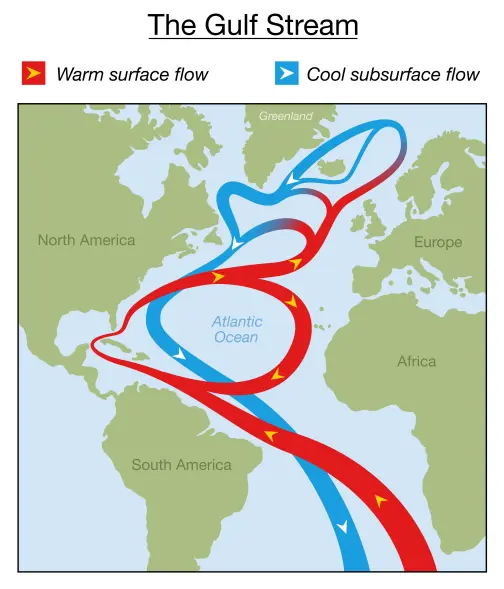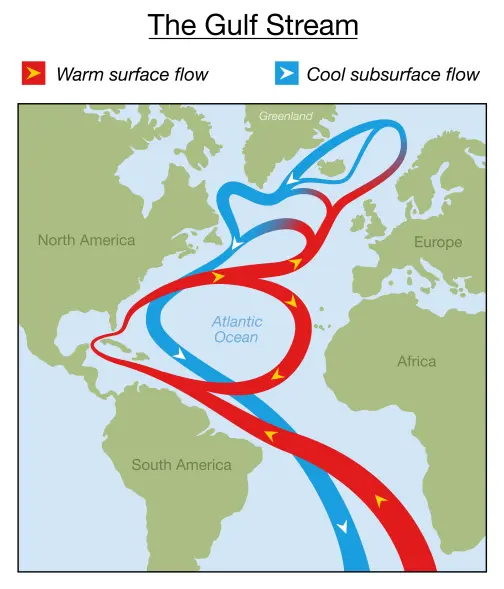Climate alarm grows as scientists warn the Gulf Stream could be on the verge of collapse — threatening a chilling new ice-age scenario
The notion that our climate crisis might herald more than just hotter summers and rising seas is disturbing in itself. But now a growing body of scientific evidence suggests that a far more dramatic shift could be underway — the weakening, and possible collapse, of the major ocean current system known as the Atlantic Meridional Overturning Circulation (AMOC), which drives the familiar Gulf Stream. In doing so, it could trigger abrupt, far-reaching changes in weather, sea levels, and even the balance of life across the Northern Hemisphere.

The Gulf Stream is one of the most powerful forces on Earth — a ribbon of warm water flowing from the Gulf of Mexico across the Atlantic, carrying heat northward and shaping climates on both sides of the ocean. It’s the reason Western Europe enjoys mild winters despite being at the same latitude as parts of Canada. It also regulates hurricanes, monsoons, and sea levels. But new data suggests this great ocean conveyor may be faltering. Meltwater from Greenland, surging freshwater runoff, and rising global temperatures are destabilizing the very mechanisms that keep it moving. Scientists warn that if this circulation slows too much, it could reach a tipping point — one from which recovery would be nearly impossible.
A major study published in Communications Earth & Environment warns that the Gulf Stream system may be closer to collapse than previously believed. Using over a century of sea-surface temperature and salinity data, researchers concluded that the AMOC — the larger circulation system that includes the Gulf Stream — could fail around the middle of this century if greenhouse gas emissions continue at their current pace. This collapse, they said, could unfold within decades, not centuries, fundamentally altering weather and ocean patterns across the globe.
The Atlantic Meridional Overturning Circulation operates like a vast heat pump, transporting warm water from the tropics toward the North Atlantic, where it cools, becomes denser, and sinks, driving the global ocean conveyor belt. But as Greenland’s ice sheet melts and floods the North Atlantic with cold, fresh water, that process is being interrupted. The delicate balance of temperature and salinity — the “engine” of the Gulf Stream — is breaking down. Once this mechanism stalls, the system could enter a new, weaker state, or even stop altogether.

The consequences would be staggering. A collapse of the Gulf Stream would likely plunge Northern Europe into bitter cold winters, drop average temperatures by several degrees, and disrupt rainfall patterns across Africa, South America, and Asia. Coastal cities along the U.S. East Coast would face sharply higher sea levels as the current’s weakening causes water to pile up nearshore. Meanwhile, monsoon systems could shift dramatically, threatening food and water supplies for billions of people. Scientists say the effects could unfold gradually at first — then accelerate rapidly once the system passes its critical threshold.
One of the most visible warning signs is the so-called “cold blob” south of Greenland — a patch of ocean that has cooled even as the rest of the planet warms. It’s believed to be caused by the influx of meltwater from Greenland’s glaciers, which prevents the salty, warm water of the Gulf Stream from sinking and circulating. This anomaly, according to oceanographers, is among the clearest indications that the Atlantic’s great heat engine is slowing down.
While the study has sparked alarm, scientists are careful to note that predictions vary. Some climate models indicate a slowdown but stop short of forecasting a full collapse. Others suggest that we may already be witnessing the early stages of irreversible change. Researchers at the Potsdam Institute for Climate Impact Research have been warning for years that the AMOC is a key “tipping element” in Earth’s climate system — one whose failure could lead to abrupt and self-reinforcing changes across the planet.

The idea of a Gulf Stream collapse conjures visions of a new ice age — and although a sudden freeze like Hollywood’s The Day After Tomorrow is unlikely, scientists agree the world would see significant regional cooling. Paradoxically, a warming planet could make some places far colder. Europe’s winters could resemble Canada’s, with harsher storms and widespread snow. At the same time, parts of the tropics could become unbearably hot and dry, creating an uneven, chaotic global climate.
In the U.S., a weakened Gulf Stream could worsen hurricanes and disrupt weather systems that farmers depend on. One study found that an AMOC slowdown could amplify heat waves in the Southeast and drive more intense nor’easters along the Atlantic coast. Rising sea levels, already a major concern, would climb even faster, inundating low-lying cities from Miami to New York.
Despite the dire warnings, not all scientists agree on the timeline. A Swiss-U.S. study published earlier this year challenged the claim that the Gulf Stream is collapsing, arguing that natural variability might explain recent anomalies. Still, even these researchers acknowledge that climate change is exerting unprecedented pressure on the system. Whether the collapse happens in decades or centuries, the trend line is clear: the AMOC is weakening, and the risks of inaction are growing.
Governments are beginning to take notice. In Iceland, officials recently classified the potential collapse of the AMOC as a national security threat, citing its possible impact on energy, fisheries, and agriculture. The European Union has called for emergency climate resilience strategies focused on North Atlantic instability. Meanwhile, global institutions like the World Meteorological Organization are urging immediate cuts in greenhouse gas emissions, emphasizing that slowing global warming is the only way to protect the oceanic systems that keep the planet stable.
For ordinary people, the implications are unsettling. The Gulf Stream has been a constant for all of recorded history — an invisible guardian that keeps Europe temperate and global weather in balance. Its potential collapse forces us to rethink everything we know about the future. Instead of asking whether the world will get hotter, scientists are now asking whether it could also, paradoxically, get much colder.
If the Gulf Stream were to collapse, humanity would face an entirely new climate regime. Food systems would be stressed, migration patterns would shift, and global economies would have to adapt to unpredictable extremes. It would not be an apocalypse overnight, but a slow unravelling — a transformation of Earth’s climate machinery that could reshape the map of habitability itself.
Yet amid the uncertainty, scientists remain united on one point: there is still time to act. The collapse of the Gulf Stream is not inevitable, but every year of inaction brings us closer. Reducing carbon emissions, preserving ice sheets, and protecting ocean health remain humanity’s best defense against the unknown.
The Gulf Stream’s steady flow has defined life for millennia. Now, as scientists warn of its fragility, the question becomes whether we can change fast enough to keep that current alive — or whether we’ll be forced to watch as the ocean that once brought warmth to the world begins to turn cold again.


